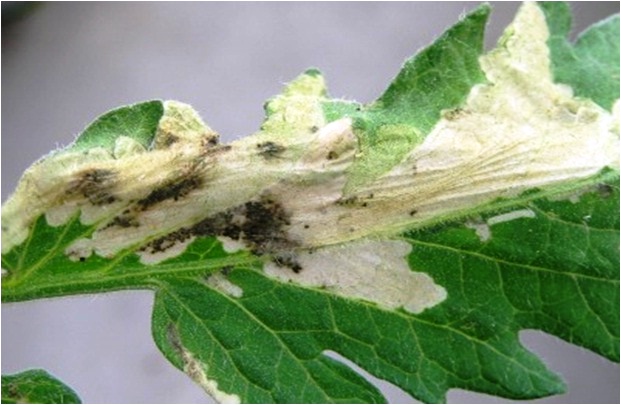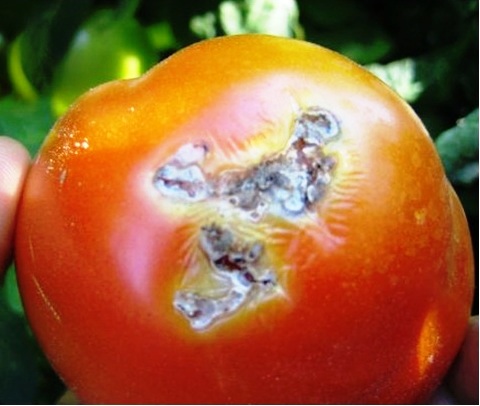Controlling the tomato leaf miner tuta absoluta |27 January 2017

Discovered earlier this month on some farms in south Mahe, what has been described as a very destructive tomato leaf miner tuta absoluta is the newest pest to join the lengthening list of destructive pests local farmers have to deal with.
While farmers are still struggling to put the white flies, eggplant borer, hairy caterpillars, fruit flies and not to forget all the other pests that are rampant and competing with them on a daily basis under control , tuta absoluta will no doubt deal them another hard blow.
Originating from South America the tuta absoluta is considered one of the most serious and destructive pests that can infest tomatoes.
More worrying for the struggling farmers is the fact that the tuta absoluta can live in different host plants of the Solanaceous family such as eggplant, capsicum, chillies, bred marten… thus making eradication and control measures in tomato plantations very difficult.
The Biosecurity Agency of the Ministry of Fisheries and Agriculture together with other concerned stakeholders have raised the alert on the infestation and are educating farmers on the measures to take on their farms.
Infestation by the pest include;
-Blotch-shaped mines in the leaves in which the caterpillars can be found
-In serious infestations leaves die off completely
-Mining damage to the stems causes malformation of the plant
Damage to the fruit gives easy access to diseases, causing decay of the fruit
Management and control measures are as follows;
-Good agricultural practices and integrated pest management should always be part of the growers’ practice for all types of pests and crops
-Monitor pests with lures and mass trapping: The use of pheromone traps can be used both to give an early warning of the presence of the pest and also to monitor the infestation density of the pest. It can also help to reduce the population when used for mass trapping in which case traps should be placed 25m apart
- Good Agricultural Practices and Integrated pest management should always be part of a growers’ practice for all types of pests and crops.
Screen Houses: Farmers can use net houses and theseshould be fitted with insect exclusion nets (mesh size 0.4 x 0.7mm) throughout and all doors capable of being sealed tightly. Any openings or gaps in the structure should be avoided. Human traffic from infested to non-infested greenhouses should be avoided.
Cultural measures: Crop rotation with non-solanaceous crops (preferably Cruciferous crops), ploughing, removal of infested plants and complete removal of post-harvest plant debris and fruit are essential.
The removal of wild solanaceous host plants in the vicinity of the growing area is also encouraged, as these can host all stages of the pest which can then re-infect the growing plants.
Non-Chemical Control: The use of Neem oil (Neem-Baan, Neemik) acts as a contact and systemic insecticide against low infestations of Tuta absoluta larva when used on the tomato plant.
The use of Bacillus thuringensis is recommended at low-medium infestation levels in conjunction with Azadiractin.
The application of dustable sulphur can also have a repellent effect on oviposition, and therefore should be used as a non-chemical preventive measure.
The use of a UV insect attractant in the greenhouse is recommended to attract adult moths, as is the use of yellow sticky traps.
The entomopathogenic fungi formulations such as Beauveria bassiana (Nilinsect, Myco-Jaal) and Metarhizium anisopliae are also effective at controlling tuta absoluta.
Chemical Control: To avoid build up of resistance in the pest, insecticides should not be used early in the cropping season and definitely not when signs of Tuta absoluta are absent. Low infestations should be controlled with the minimal application frequency possible of chemical insecticides. When chemical insecticides are to be used for the control of an infestation, different active ingredients should be used alternately and not mixed together all at once, otherwise this will allow the pest to build up resistance in a shorter span of time.
The following active ingredients are suggested for the control of Tuta absoluta: Imidacloprid (Confidor), Indoxacarb, Spinosad (Laser), Deltamethrin (Decis) (against adult moths), Rynaxypyr (Altacor, Coragen) and Cartap (Suntap)





